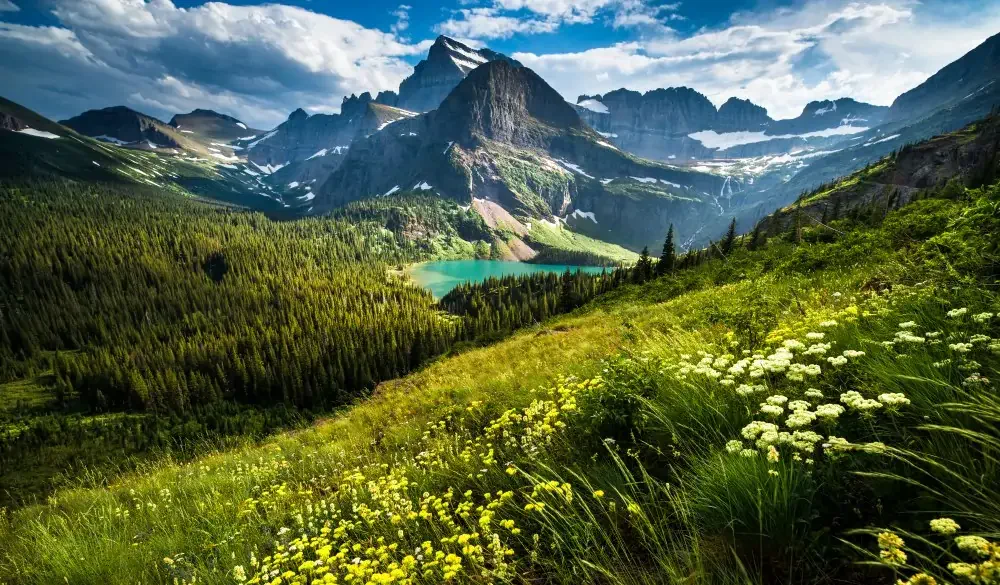In 2019, UNESCO threatened to strip Venice of its World Heritage status after it suffered some of the worst flooding seen in decades. A site of “outstanding universal value,” the Floating City’s struggles with climate change, mass tourism, and soaring living costs have led it to be considered one of Europe’s most endangered travel destinations. Some experts have even warned that rising sea levels could submerge Venice permanently by 2050.

That’s an alarming prospect, and around the world, the story is very much the same. Currently, 53 other endangered travel destinations are on UNESCO’s List of World Heritage in Danger, while countless others, such as Thailand’s Maya Bay, have been pushed to the brink of total erasure. For that to happen would be devastating. As travelers, it’s our responsibility to educate ourselves properly about these endangered travel destinations before we visit them.

With over 400 million annual visitors to HotelsCombined, we’ve compiled a list of endangered travel destinations that you can still visit sustainably. Given the threats to each of these remarkable sites, we’ve also included suggestions for how you can minimize the impact of your visit. To that end, you’ll also find some of our favorite eco-friendly hotels in the local area.
1. The Maldives
Set in sapphire waters and surrounded by many-colored coral reefs, The Maldives is the epitome of an island paradise. However, in less than 100 years, the entire island nation could disappear completely. Around 80% of the Maldives’ territory sits at less than 1 meter above sea level. With studies warning of a 1.3-meter rise in sea levels within the next century, the Maldives could easily become climate change’s first countrywide casualty. Equally dire is the outlook for the archipelago’s fragile marine parks, where corral death threatens diverse populations of parrotfish, green turtles, and manta rays.


What Can You Do?
The Maldive’s land area is tiny — less than a tenth of the size of Rhode Island — so everything you bring into the country needs to leave with you too. Avoid the use of single-use plastics wherever possible, don’t smoke on the beaches, and pick up any litter you find on the sand. Make diving and snorkeling experiences as unintrusive as possible by keeping your distance from marine life whenever possible. Do not remove anything from the seabed, dead or alive.
Best Sustainable Resort in the Maldives: Six Senses Laamu

Six Senses Laamu’s idyllic atoll setting makes it easily one of our favorite waterfront resorts of all time. If the dreamy beach cabins and overwater villas (with private infinity pools!) don’t instantly win you over, its commitment to the environment certainly will. In 2018, Six Senses Laamu took on the considerable challenge of making not the resort but the entire Laamu atoll 100% plastic-free within four years. They’re achieving this in part through the donation of 55 desalinating systems to local schools, pre-schools, and households. This will help over 3,949 local people access clean drinking water without relying on bottled water shipments. This focus on sustainability is just one reason why Six Senses Laamu was made Eco-Resort of the Year by local tourism authority MATATO.
Other reasons to love this resort:
- The resort has partnered with three local foundations to protect over 500 resident turtles and 131 resident manta rays.
- A portion of resort revenues goes toward research, education, conservation, and outreach. That includes 100% of all soft toy sales, so spoil the kids while you’re out there.
- Guests can go on a Back-of-House Tour, where they can learn all about Six Senses Laamu’s efforts to preserve the local environment on and offshore.
Star Rating: 5*
Price: USD 2,551 – USD 3,719
Guest Rating: 9.5
Address: Olhuveli Island, Olhuveli Island 08290, Maldives
Hotel Location
2. Taj Mahal
Built by Emperor Shah Jahan as a mausoleum for this late wife Mumtaz Mahal, this imposing labor of love is now one of India’s most endangered travel destinations. Taj Mahal is located in Agra, which despite its wealth of Mughal-era buildings is also the world’s eighth most polluted city. Sadly, that dismal distinction is taking its toll on Agra’s most valuable cultural monuments. Fumes from nearby smokestacks and exhausts are actually staining the Taj Mahal’s characteristic white marblework. Conservationists are using chemical-free mudpack to restore the mausoleum’s original brightness. However, it’s a slow process and one that will only yield permanent results if Agra is able to drastically reduce local pollution.


What Can You Do?
While you might not be able to solve Agra’s environmental issues, you can help improve the state of tourism in India. Poor media representation, fetishization of local people, and over-tourism to principle sites have all been harmful to India’s image abroad. Fortunately, all you need to be a conscious tourist is a little common sense. Avoid slum tours and other invasive experiences, think twice before you snap pictures of street children, and try to space out visits to major tourist spots by visiting some of Agra’s lesser-known sites. You’ll be helping ease the crowds and getting off the beaten track at the same time.
Most Socially Responsible Hotel near Taj Mahal: The Oberoi Amarvilas

Built-in the resplendent style of a 16th-century Mughal Palace, The Oberoi Amarvila’s terraces, fountains, and domed cupolas make it one of Agra’s most historically interesting hotels. What is really conversation-worthy, though, is the way the hotel gives back to local communities. Since 2014, Oberoi has partnered with SOS Children’s Villages to provide for the upbringing and education of 210 homeless, parentless, or abandoned children. In addition to providing the kids with a place to stay and study, they also offer vocational training programs for older teens, so that they can support themselves after high school.
Other reasons to love this hotel:
- You can dine under the stars with a four-course meal and personal butler service.
- Opt for a Deluxe Suite and you’ll have sublime views of the Taj Mahal all to yourself
- Personalized yoga sessions are held in the hotel’s ivory-colored courtyards.
Star Rating: 5*
Price: USD $806 – USD 17,381
Guest Rating: 9.5
Address: Taj East Gate Road, Āgra, India
Hotel Location
3. The Pyramids of Giza
It’s hard to think that a complex that has existed for over 4,000 years could one day disappear. However, that’s exactly the concern some experts have about this historic Egyptian site. All four of The Pyramids of Giza’s pharaonic structures — including the Sphinx and Great Pyramid of Khufu — are under threat from above and below. Research shows that sewage and rising groundwater has begun to destabilize the rock on which the structures stand. Meanwhile, airborne pollution is causing their surfaces to erode away. There’s still time to save the last extant ancient wonder of the world, but if nothing is done, it could be lost to the sands of time.


What Can You Do?
A camel ride around Giza’s desert tombs is by far one of the most popular tourist experiences at the pyramids. It’s also one that comes with a large ethical question mark attached. Locals often get into the camel ride gig as a means to a very quick buck, and that mentality is reflected in the welfare of the animals. The jury is still out on whether any camel riding at all can be considered humane. If you are going to opt for a camel tour, do your research first and see how the animals are trained. If your guide hasn’t enough camels for your group and has to borrow one, that’s a guaranteed red flag.
Most Remarkable Local Hotel: Marriott Mena House Cairo

Imagine rising every morning to the timeless silhouette of one of the ancient world’s greatest achievement of engineering. In part due to its unparalleled pyramidic views, this historic hotel’s star-studded list of former guests includes Frank Sinatra, Charlie Chaplin, and Agatha Christie. Follow famed footsteps along the paths of its lush 40-acre gardens, and admire the endurance from one of two expansive outdoor swimming pools.
Other reasons to love this resort:
- Alfresco dining at Alfredo, a gorgeous open-air eatery with historically inspired decor.
- The private balconies in the garden-view rooms open out onto the pool deck and water features
- The magnificent Al Khalifa Meeting Room dazzles with its Islamic-style gates and gold finishes.
Star Rating: 5*
Price: USD 149 – USD 324
Guest Rating: 8.7
Address: 6 Pyramids Road, Giza 12556, Egypt
Hotel Location
4. Great Wall of China
First built over 2,000 years ago to keep out foreign intruders, the Great Wall of China is now straining under the pressure of mass tourism from both sides of the border. In 2018, over 10 million tourists, domestic and international, descended on Badaling, the wall’s most well-known section. That led local authorities to set up a visitor cap of 65,000 people per day. However, that hasn’t stopped the looters, wind erosion, and vandals who pull out individual bricks to sell as souvenirs. Together, they’ve wiped out over 30% of this frontier-striding monument, making it one of China’s most endangered travel destinations.


What Can You Do?
First off, don’t buy any bricks that have been pulled off the wall — that one’s a given. However, there’s plenty more you can do to reduce your impact on the time-worn structure. Opt for a section of the wall away from the crowds, such as this lesser-visited section with local guide Dong Zhao. Night hikes are another fantastic way of experiencing a little solitude on the serpentine landmark. That being said, avoid tours that allow you to camp on the wall, unless you want to contribute to this endangered travel destination’s demise.
Best Sustainable Hotel Nearby: Commune by the Great Wall

While it might not be on the same level as the Wall itself, Commune by the Great Wall is an architectural masterpiece. A series of modernist structures by 12 Asian architects, it was exhibited at the 2002 Venice Biennale and received a special prize. Rectangular and topheavy in design, Commune’s earth-toned buildings rise out the quiet Beijing hillside, creating a unique environment from which to experience the wall.
You’ll be staying in Badaling, but don’t worry about the crowds. A marvelous feature of this futuristic Chinese hotel is that it has its own private footpath to a secluded stretch of the Ming-Dynasty fortification. So you can cut out the crowds, and experience the Wall without contributing to the heavy foot traffic that is wearing down some of its more well-known stretches.
Other reasons to love this hotel:
- You can stay in a work of art. Commune features 12 striking villas, each designed by a prominent Asian architect.
- Outdoor activities, like swimming, tennis, and nature hikes, allow you to properly savor life in this photogenic part of the Chinese countryside.
- Terrace Lounge serves al-fresco fare against the dreamy backdrop of the Shuiguan Mountains.
Star Rating: 4*
Price: USD 253 – USD 1,921
Guest Rating: 7.7
Address: The Great Wall Exit No.53 at Shuiguan G6 Jingzang Highway, Badaling 102102, China
Hotel Location
5. Komodo Island
With its extraterrestrial landscapes of skeletal rises and secluded coves, Komodo Island is easily one of Indonesia’s most beautiful places. While the island’s unique shape and desolate beauty isn’t going anywhere, the threat to its biodiversity has reached critical levels. Ocean acidification and coral bleaching are among the threats to the island’s varied marine life. However, it’s the future of Komodo’s eponymous lizards that has led many to consider the island and its neighbors Rinca, Motang, and Kode as endangered travel destinations. Just under half of the world’s 5,700 Komodo dragons live here, and their numbers are faltering. Local authorities are reviewing how they can reconcile Komodo’s fragile ecosystem with its heavy reliance on tourism, and they’ve closed the island for the duration of 2020. Hopefully, by the time Komodo reopens, some of the ethical concerns surrounding this spectacular region will have been addressed.


What Can You Do?
On the off-chance, that safe international travel resumes before the end of the year, you can still see wild Komodo dragons on Rinca island, which has about 1185 individuals. Whichever of the islands you visit though, make sure you leave no trace. Trash and leftover food are two factors that have contributed to the Komodos decline in numbers.

Best Sustainable Resort near Komodo Island: Komodo Dive Resort
Splendid isolation, unmatched diving, traditional beachfront huts. There’s plenty of reasons to fall for this dive resort on Sebayur Island. Arguably its most appealing feature, however, is an unfailing dedication to preserving the local environment. Komodo Dive Resort goes to great lengths to defend its local coral system, educating guests on where they can and can’t go in the water. Plastic straws and single-use bottles are nonexistent, and much of the resort’s power comes from photovoltaic cells. It’s sensible eco-tourism, plain and simple.
Other reasons to love this resort:
- You can stay aboard a vessel and tour around the Komodo archipelago over multiple days, the closest you’ll come to staying on the island.
- Their dive center offers a comprehensive range of PADI-certified courses, from Open Water to Dive Master.
- Cozy Komodo Dragon Beach Bar’s bean bags and local beers are the perfect kickback at the end of the day
Star Rating: 3*
Price: USD 141 – USD 527
Guest Rating: 8.8
Address: Tanjung Pelinta, Pulau Sebayur, Komodo, Labuan Bajo 86754, Indonesia Show Map
Hotel Location
6. The Dead Sea
The spiritually significant salt lake is known for its low elevation and the healing properties of its briny water. But at current rates, the Dead Sea could ebb away into nonexistence. Water levels have dropped by an alarming 80% in recent decades and continue to lower at a pace of 3 feet a year. Frustratingly, the Dead Sea’s imminent demise is being caused by the unsustainable exploitation of its sole water source, the River Jordan.


What Can You Do?
There’s not much you can do to make the tides come back in — though luckily a joint authority is building a giant pipeline to the Red Sea to reduce reliance on the River Jordan. Even so, there are some things you should take note of for your own benefit before bathing in the brine or take a magnificent mud bath.
Stay out of the water if you have any open cuts, as they will smart and sting in the water. For the same reason, it’s best to wait until after you swim to engage in activities like canyoning, hiking, and any others where you might risk getting bumps and scratches. You also do not want to get the water in your eyes or mouth. At 10 times saltier than ocean water, it’s toxic to ingest.
Best Wellness Resort Near the Dead Sea: Isrotel Dead Sea Hotel & Spa

With its fantastic wellness center and breezy waterfront gardens, Isrotel is the ultimate detox destination. After bathing in the Dead Sea’s therapeutic brine, stop by the Esprit Spa for a mud wrap sourced right from the lake. The airy contemporary-style rooms and suites feature beautiful desert views. To take full advantage of your surroundings, ask to stay in the Dead Sea View Suite, which also has a jacuzzi.
Other reasons to love this resort:
- You can spend an entire afternoon chilling out at the rooftop solarium, with spectacular views of the surrounding mountains.
- Isrotel’s wellness center features tension-easying sulfur pools, as well as a wet and dry sauna.
- Ranch House Restaurant serves substantial steaks and other international comfort foods.
Star Rating: 5*
Price: USD 220 – USD 3,004
Guest Rating: 8.1
Address: Ein Bokek, Ein Bokek, HaDarom (Southern), Israel
Hotel Location
7. Machu Picchu, Peru
The ethereal Incan citadel likely had a population of fewer than a thousand people in its heyday. It certainly wasn’t built for half a million tourists that visited every in 2016. Constant foot traffic led to Machu Picchu being listed on UNESCO’s list of endangered travel destinations in 2016. Since then, the Peruvian government has instituted a daily cap of 2,500 visitors, as well as a half-day ticketing system it hopes will reduce crowding. Natural erosion and landslides caused by heavy rains are a secondary menace, experts have pointed to climate change as the cause.


What Can You Do?
When you pick up your ticket for the morning (6 a.m.–midday) or afternoon (midday–5.30 p.m.) slots, you’ll be told you access the Lost City via one of three approved trails. Stick to the trails. They were marked out to protect Machu Picchu and keep visitors away from some very precipitous falls — don’t forget: it’s on a mountain.
As with all endangered travel destinations, make sure you leave Machu Picchu without a trace. It’s not just that you’ll be keeping the site clean and presentable for the thousands of other visitors, some of whom see Machu Picchu as a spiritual place. You’ll also be helping the authorities with a serious logistical issue. All of Machu Picchu’s waste has to be transported from Machu Picchu to nearby Cusco City by train.
Best Cultural Stay Near Machu Picchu: SUMAQ Machu Picchu Hotel

Hugging the vertical rise of a valley wall, Sumaq is a splendid tribute to Incan heritage. Visually, you’ll get your fill of breathtaking local art before you even start up the Inca Trail; the hotel boasts a collection of over 300 dazzling pieces. An even more nourishing experience is the delicate tasting menu prepared by Carlos Pardo Figueroa and Ribelino Alegría, who work with local communities in the sierra’s upper reachers to source ingredients and flavors you won’t find down in the lowlands. Sumaq, by the way, means “delicious” in Quecha.
Other reasons to love this resort:
- It has one of the world’s most beautiful bathtubs, offering discrete corner views of the sierra and babbling Vilcanota River.
- Suquy Café & Bar is the perfect spot for a pisco sour — and a number of exotic local tipples
- You can take a shamanic journey into the mountains with the Mystical Tour in Machu Picchu.
Star Rating: 5*
Price: USD 330 – USD 1,667
Guest Rating: 9.0
Address: Av. Hermanos Ayar Mz 1 Lote 3, Machu Picchu 00000, Peru
Hotel Location
8. Glacier National Park, US
In a few decades, climate change could rob one of the US’s most stunning national parks of its namesake. Glacier National Park’s original 150 ice flows have all but evaporated over the past several decades. Today, there are only 25. While remaining masses like Sexton Glacier make this a stunning place to get away from the crowds, Glacier’s appeal could have melted away by 2030.


What Can You Do?
Glacial retreat is emphatically tied to climate change. So before, during, and after your stay in Glacier National Park, do what you can to cut down on energy usage. Turn off lights when you’re not in the room, use aircon sparingly, and go easy on the thermostat. While you’re in the park, hike responsibly. As frustratingly egregious as it is, Glacier has actually publicly asked visitors not to treat it like a garbage can. We all wish it didn’t have to be said, but hang on to your trash until you find the end of a trail. If there’s one thing that needs to be erased from all endangered travel destinations, it’s litterbugs.
Great Nearby Lodge: Cedar Creek Lodge & Conference Center

Cedar Creek Lodge is located just outside the national park, in Columbia Falls. This makes it the ideal choice for any traveler who wants to visit Glacier, when the crowds, but also in park accommodation, are nowhere to be seen. Cozy alpine-leaning rooms and suites charming getaway at any time of year. But if you’re visiting in winter, Cedar Creek Lodge’s proximity to Whitefish makes it an excellent choice for skiers.
Other reasons to love this resort:
- The heated indoor pool and hot tub are perfect places to warm yourself through after a bracing hike on the hillside.
- Open-topped bus tours through the Glacier’s east and west sides, featuring some marvelous mountain vistas.
- The hearty complimentary breakfast spread will get you going before you hit the trails.
Star Rating: 4*
Price: USD 255 – USD 375
Guest Rating: 9.4
Address: 930 2nd Ave W, Columbia Falls, MT 59912, United States
Hotel Location
Help Preserve The World’s Endangered Travel Destinations

It’s not a one-man job. Doing your bit to aid in the conservation of the world’s endangered travel destinations can be as simple as leading a greener existence. Protect crucial marine habitats like the Great Barrier Reef and Henderson Island by minimizing the amount of plastic waste you generate. Think twice before engaging in any tourist experiences that might be unethical or unsustainable. And at home, check out local organizations for ways you can get involved in cultural and natural conservation (like these in the US and Australia). Many of the world’s endangered travel destinations are hurtling toward an uncertain future. If we want to stop them from disappearing, we need to act fast.







